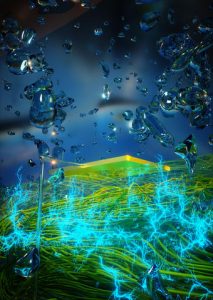
A team of researchers has found a way of generating electricity literally out of thin air that they are calling “Air-gen”, a device that not only requires no rare or toxic chemicals to run, but instead runs on the ambient humidity that typically lingers in the air.
The Air-gen device builds upon the 2020 discovery that electricity can be drawn from the humidity in the air using thin film woven from protein-based nanowires: basically, there’s plenty of ions in water—including the water vapor that makes up the humidity in the air—that can be used to create a useable electrical current if a charge imbalance can be created in a given material.
While the nanowires in the previous experiment were made by harvesting the extremely fine fibers from bacteria that were genetically-modified to produce them, this new development has found that the process doesn’t actually require exotic materials to work: virtually any material can be used to draw electricity from the air—provided it is properly structured to do so.
Regardless of what material is used, be it silicon, wood or metal, it needs to be broken down into extremely small particles and re-formed so that it is permeated by nanopores that are under 100 nanometers in size, less than one thousandth of the width of a human hair. These pores allow the water molecules in the air to pass through them, but the material gathers the ions carried by the molecules as they pass through it.
Most of the charge builds up in the material closer to the entrance of the assembly, creating a charge imbalance within it, causing an electrical current to flow that can be drawn off to power a device; the discharge that occurs is similar in effect to when you get a static shock from the charge imbalance created from shuffling your feet over a carpet and touching a doorknob—you draw ions off of the floor and store the charge in your body—or like the discharge of lightning from a thunderstorm, although Air-gen does so in a much less violent manner.
“What we have invented, you can imagine it’s like a small-scale, man-made cloud,” explained senior study author Jun Yao, a professor of engineering at the University of Massachusetts at Amherst. “This is really a very easily accessible, enormous source of continuous clean electricity. Imagine having clean electricity available wherever you go.”
The Air-gen prototypes Yao’s team is working on are currently just the size of a typical fingernail, and generate about nine-tenths of a volt; the researchers calculate that a billion of these units could be built into a refrigerator-sized battery that could produce about a thousand watts of energy, enough power to run more than 110 LED light bulbs, or a small air conditioner.
Air-gen does have a number of limitations: Yao’s team is still working on how to scale up the fabrication of the nanopore-bearing material for mass production, although that’s simply an engineering problem that will be solved sooner rather than later. It also requires air that has more than 60 percent humidity to work—the generators won’t be useful during dry winter months or in arid regions—although there are numerous locales around the globe that experience chronic humidity where electrical power is difficult to obtain.
The researchers are also experimenting with different materials to try to discover what substances offer the best generating efficiency so that smaller units with the same generating capacity can be built, or perhaps ones that can be used in areas with less humidity. “Once we optimize this, you can put it anywhere,” according to Yao.
“The entire earth is covered with a thick layer of humidity,” Yao remarked. “It’s an enormous source of clean energy. This is just the beginning in making use of that.”
Subscribers, to watch the subscriber version of the video, first log in then click on Dreamland Subscriber-Only Video Podcast link.
Thanks for this article!
I feel heartened to read this information.
Every effort needs to be put into making this work on a global scale and with urgency . We don’t have the luxury of time on our side .
I can feel the energy in the air when it’s humid, any time a humid system comes through.